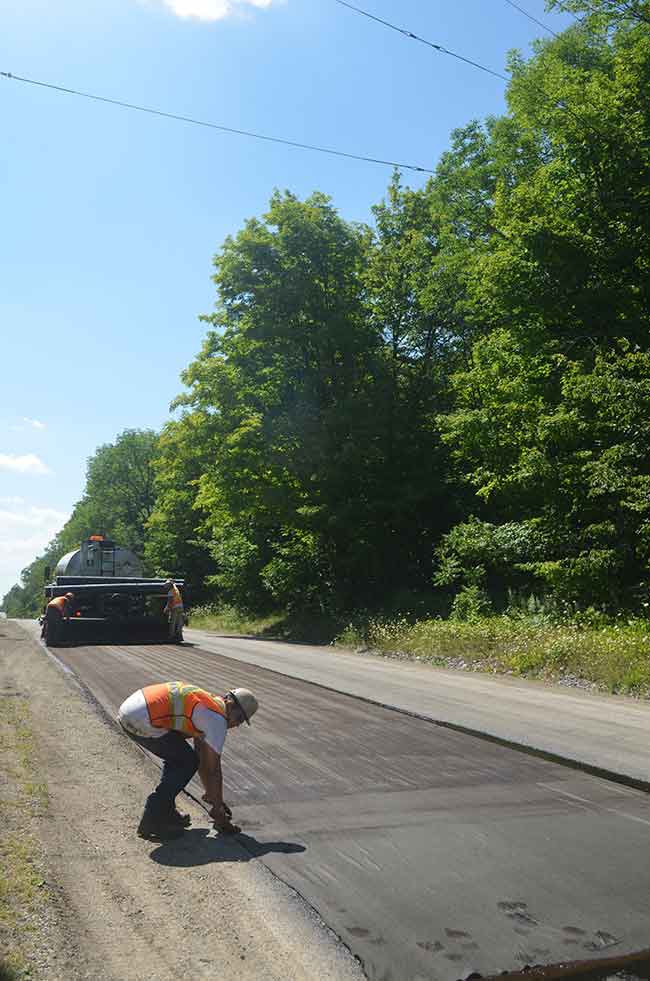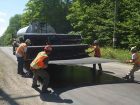
Features
Projects
Roads & Paving
Geotextile growing
Miller Paving's road preservation process in high demand
October 11, 2016 By Andrew Snook

October 11, 2016 – The 2016 paving season has been a busy one for Miller Paving’s team in Stouffville, Ont.
The company has experienced a spike in the installation of geotextile paving fabrics in its road preservation operations throughout Southern Ontario, and doesn’t look to be slowing down.
To learn more, Rock to Road visited the company’s headquarters in Stouffville and checked out one of the installations firsthand to learn more about local municipalities’ growing interest in the geotextile paving fabric technology and Miller Paving’s road preservation processes.
“Basically, it’s a geotextile reinforced chip seal,” explains Matthew Luzi, operations coordinator for Miller Paving’s Pavement Products Group.
The product itself is not new to Ontario. Miller Paving began using it in trials in 2007. The company’s first project involving the fabric was a 300-metre trial on a roadway in Haliburton County. It’s still on the road today, performing well.
“The county marked out the worst 300 metres in a section of roadway to perform their trial,” recalls Peter Linton, general manager of Ontario Pavement Products Group at Miller Paving. “We incorporate a non-woven geotextile within a double chip seal – a layer of binder, layer of fabric then two layers of binder and chips. It’s 2016, so it’s in its ninth summer. We were unsure of the performance and life-cycle at that time but we’ve certainly found that out.”
Every year since the trial, Miller Paving has been using the geotextile fabric in some of its operations and its demand keeps growing amongst municipalities within Ontario.
“It’s taken off as far as our customer base goes,” Linton says. “They keep calling the tenders for it.”
From 2011 to 2015, Linton estimates that Miller Paving has completed somewhere between 30 and 40 two-lane kilometres of roadway using the geotextile fabric. This year alone they’ve performed 60.5 two-lane kilometres of roadwork using this technology in numerous regions and municipalities.
How it works
The geotextile fabric can be used in multiple applications for preserving roads.
Miller typically uses it in a unique process with a chip seal to provide a Stress Absorbing Membrane (SAM). The fabric comes on rolls that are attached to the back of a truck as an attachment. The rolls have bearings that allow the fabric to roll off and be applied to the roadways.
“This particular product has been used in the U.S., mostly the southern U.S., as an interlayer to combat reflective cracking,” Linton explains. “We’re using it in a similar application but we’ve widened our area of application to incorporate it into chip seals. We’re applying it on aggregate surfaces as well, like gravel surfaces. In that situation it’s not used to combat reflective cracking. It’s used to strengthen the surface treatment and prevent water from getting into the underlying materials, which weakens the paving structure.”
For the geotextile fabric to be useful for strengthening surface treatments, it must be completely saturated in binder.
“I think of it like a shingle,” Linton says. “Once the fabric is saturated in binder and cured it performs like an asphalt shingle – it’s water impermeable. Potential cons of surface treatment are the edge cracking that takes place and the potholing. This product helps strengthen the structure of the surface treatment over a gravel roadway, reducing edge cracking and the formation of potholes.
“When you’re using it as an interlayer to combat reflective cracking, you’re doing that as well – keeping moisture from getting into the cracks of existing pavement and becoming bigger – and you’re increasing the life of the actual chip seal.”
An unpopular choice?
The geotextile fabric appears to be successful in its application and is in increasingly high demand amongst municipalities in Ontario, so why aren’t more companies using this technology?
Linton says it’s a combination of a lack of knowledge about its benefits and a refusal from some paving companies to break away from more traditional methods.
“Miller Paving tries not to be the status quo; we like to go above and beyond,” Linton says. “We constantly market and develop innovative technologies to enhance existing processes. Our customers have become accustomed to this and have been willing participants in the trials of these processes.”
Prep and placement
Preparation and placement processes are outlined in sections 6.1 and 6.2 of A Three-Year Experience Review of Geotextile Paving Fabrics in Ontario, written by Peter Linton and Trevor Moore, technical director of Ontario Pavement Products for Miller Paving:
6.1 Surface Preparation
For existing HMA [hot-mix asphalt] or seal coat substrates, the existing surface shall be free of debris and standing water to ensure an adequate bond is achieved between the emulsified asphalt and the existing substrate. Extra care may be required when removing debris on milled surfaces to ensure a clean surface is achieved.
For pulverized or granular surfaces, the substrate must be graded and compacted to the desired final cross and grade. The surface must also be dampened immediately prior to the fabric application to promote adhesion of the bitumen emulsion to the substrate.
For construction in an urban cross section, the existing asphalt must be cold milled when employing a SAMI. In addition, the utilities must be protected from material intrusion by installing temporary covers. After the fabric is placed, it is cut to the required shape and size to fit around the protected structure and the temporary cover is removed.
6.2 Placement
After the surface has been prepared, the materials are applied to the roadway. Emulsified asphalt is applied with a distributor and the cover aggregate is applied via an aggregate spreader. Prior to use, both pieces of equipment are calibrated according to the their respective protocols to ensure the design rates are applied accurately across the design width. It is important to prevent traffic from driving on the treated section until final rolling has terminated.
A secondary application of bitumen emulsion is then immediately sprayed to ensure complete saturation of the fabric and to adhere the aggregate to the fabric. For the work performed to date, the same emulsified asphalt type is utilized throughout the entire process for each roadway. The desired aggregate is then immediately spread on the secondary binder application and compacted with the required rollers.
Compaction is imperative for the system to be effective, as the rollers need to embed the cover aggregate into the bitumen emulsion fabric composite. Compaction of the seal coat completes the operation when a SAMI is employed. However, when a SAMI is utilized an additional application of bitumen emulsion and cover aggregate are applied to achieve a double seal coat.
Print this page




